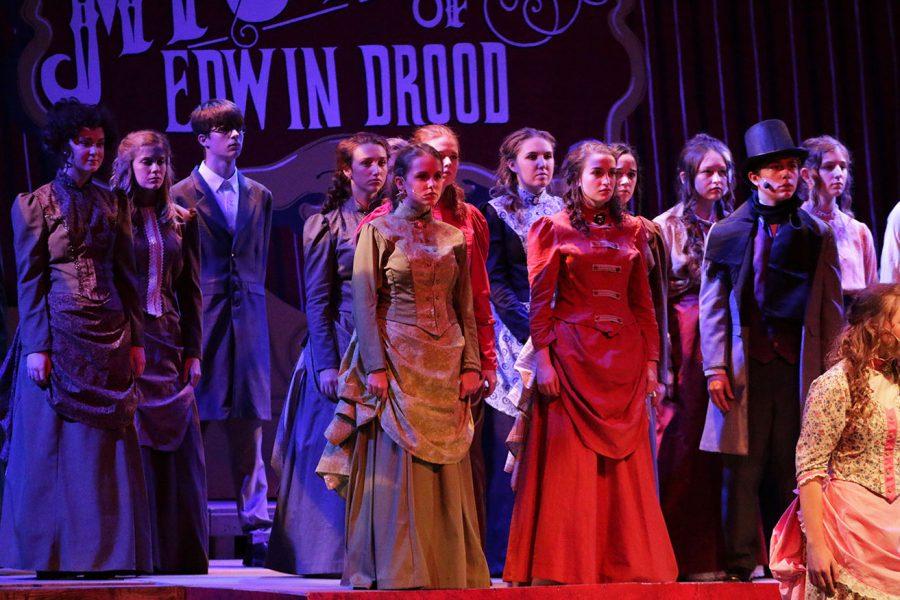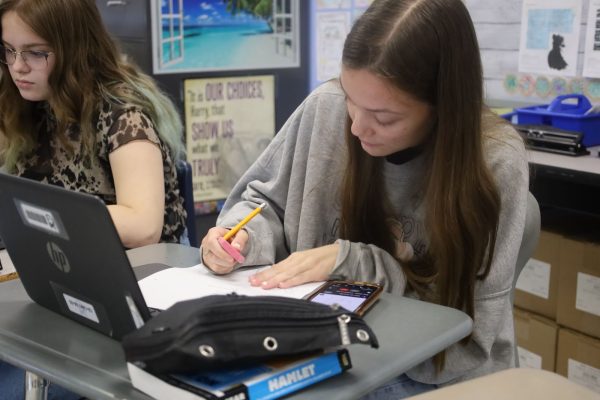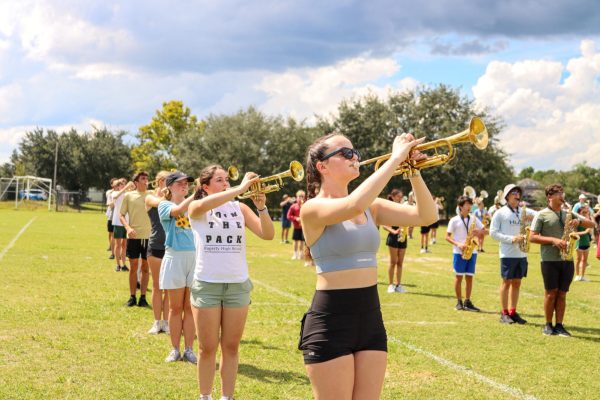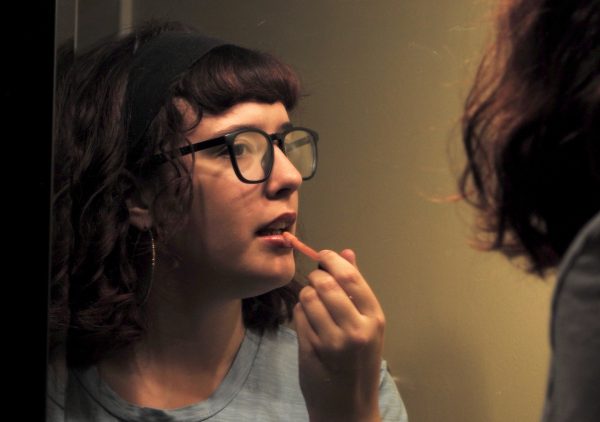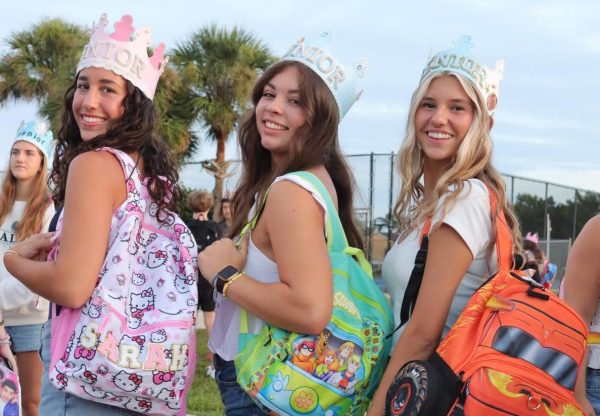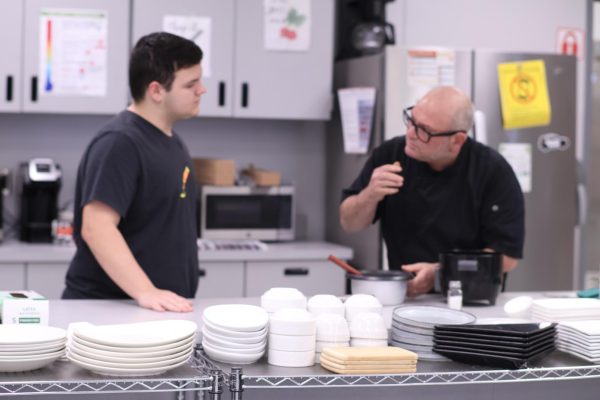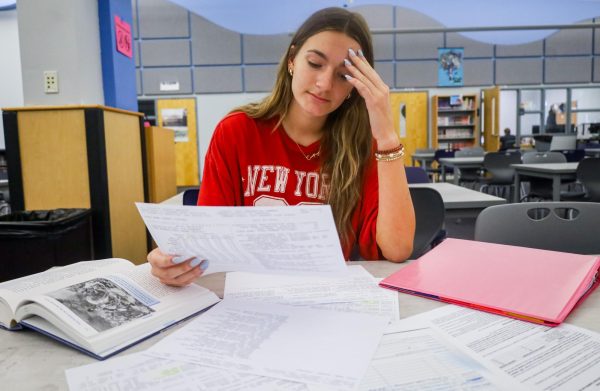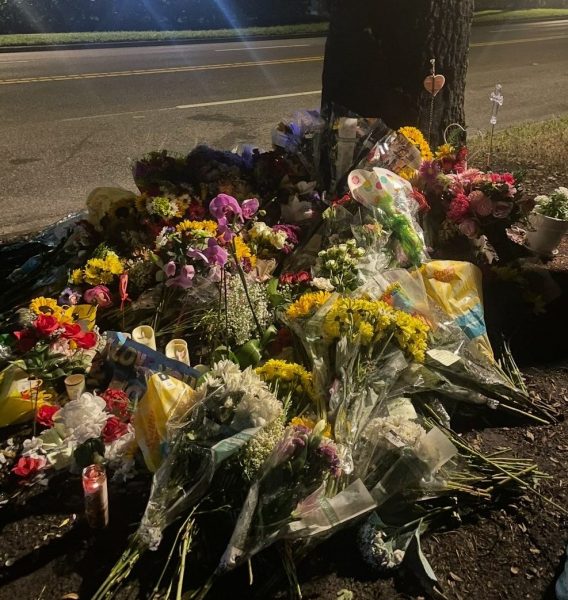Mystery solved
photo by Bailey C. Fisher
The cast of “The Mystery of Edwin Drood” stands together during a scene during their dress rehearsal on Wednesday, Nov. 3. Night rehearsals like this one were frequent and mostly done the week of and before the opening night.
It is 11 p.m. when senior Sarah Halverson finally gets back to her car. For the last 12 hours she has been rehearsing a combination of songs for the fall musical not for one character, but two. Not for one ending, but five.
Usually, for past fall musicals, the cast and crew have focused on how the stage will be set up, who will sing what songs and when and, especially, how opening night will go. But this particular show was different.
Unlike the rest, “The Mystery of Edwin Drood,” based on the unfinished 1870 novel by Charles Dickens, is a play within a play. While the cast had to rehearse their main character’s songs and British accents (cockney and high-class), they also had to memorize a sub character and the songs that character had to sing.
The story outlines a group of actors in Victorian England who get together to finish the novel in a series of scenes and leave it up to the audience to decide what happens at the end. Near the end, where Dickens was unable to finish the story, the cast spread out into the audience and tallied up votes on who they wanted to be the murderer of Edwin Drood, the detective and the two lovers each night.
Senior Madison Barrett, who played one of the lead roles as Rosa Bud and Deirdre Peregrine, was one of the candidates for the murderer of Drood and had to rehearse and be ready for anything on the nights of the performance. She was picked for the murderer opening night and recalls that the audience was extremely interactive and that her solo was the strongest she had ever performed.
“[Opening night] was amazing. It was definitely the best night of my life,” Barrett said. “I was just in the moment for the entire show while feeling so many emotions and that usually never happens to me.”
Sophomore Vangeli Tsompanidis also held a lead role as John Jasper and Clive Paget and a possible murderer, but did not get picked opening night. While he and several others had songs rehearsed to perform if they got selected by the audience, according to the ones who were not, it was nothing short of inspiring.
“Even though my character gets to perform [a solo] every night, it would’ve been amazing to be the murderer,” Tsompanidis said. “I think the performances went incredibly well aside from a few technical difficulties. I’m very proud of them.”
Audience members were welcomed into the auditorium each night by all of the cast members introducing themselves and showing them to their seats with accents that corresponded to their character. This was also done at intermission where cast members came back outside and sat with some of the audience members to ask them how the show was so far. According to much of the cast, this was done so there was interaction with the audience before the voting for the ending began.
Since this show is very rarely done on stage by high school productions and because it involves the audience more than other shows, the cast and crew worked until the last day to put the finishing touches on this performance. Night rehearsals and even weekend rehearsals became routine, and many were done the week of the shows.
While rehearsals were more frequent for this show than previous ones, the music was also rehearsed over the summer with professional musicians so that each actor was never unprepared and was ready to practice on the first day back to school. Costumes and stage design began shortly after and certain aspects of the entire show were still being added the week before opening night, according to senior and costume coordinator, Jacklyn Kareem.
The biggest strain, according to the director Trevor Southworth, was running through each possible ending and making sure the cast was ready for the quick transitions within the show. Most of the dress rehearsals done days before the opening night encompassed a mini live audience full of parents and other family members to see the chances of certain cast members getting selected.
“The difficult thing about preparing was the fact that they could’ve done none of their individual songs or they could’ve done all of them in one night,” Southworth said. “There were about 400 different combinations that could’ve happened, and the cast had to prepare for all of them.”
Your donation will support the student journalists of Hagerty High School. We are an ad-free publication, and your contribution helps us publish six issues of the BluePrint and cover our annual website hosting costs. Thank you so much!

